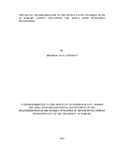| dc.description.abstract | Housing the growing population in Kenya remains one of the greatest challenges of achieving
the Millennium Development Goal 1. The recent proliferation of slums represents the
insufficiency of resources and physical planning policies and regulations. Slum
redevelopment strategies are often conceived as the solution to stop further growth of slums.
Locally one such strategy is Kenya Slum Upgrading Programme (KENSUP) which was
launched in 2004 piloted in the Kibera Soweto east Village.
Guided by the need to ensure that development interventions place the people first in such
strategies the study was therefore designed to answer the following questions: What are the
social and economic effects of the Kenya Slum Upgrading Programme on the Kibera
residents? How are the Kibera slum residents coping with the transformation as a result of the
slum upgrading? Accordingly the overall objective of the study was to explore how the lives
of the Kibera slum residents have been transformed following the slum upgrading
programme. The specific objectives of the study were to investigate the socio-economic
effects of the slum upgrading programme and to find out the coping strategies the Kibera
slum residents have developed as a response to the slum upgrading programme.
The study was guided by the Modernisation Theory as propagated by Walter Rostow (1960).
This is a grand theory of development that states that development can be achieved by
following the processes followed by what is now the ‘developed world’. This theory is
premised on the idea of replication of change.
Data were collected using the survey method, focus group discussions and key informant
interviews. In total, ninety-two residents were drawn from the Soweto east area and environs
and subjected to a structured questionnaire. Four focus group discussions were held
comprising of eight to ten participants obtained from the study site. Seven key informants
were subjected to in-depth interviews on the topic of the Kenya slum upgrading programme
and Kibera residents.
The Statistical Package for Social Sciences (SPSS) was used in the analysis of the
quantitative data collected through the survey method. The data were categorized, arranged
and summarized and presented using tabulations, pie charts and bar graphs. On the other
hand, qualitative data collected through focus group discussions and key informant interviews
xii
were analyzed thematically. Content analysis, direct quotations and selected comments from
the informants were used to present the findings.
The findings suggest that a majority of the slum residents are indeed aware of KENSUP but
the information they have is scanty. As such the residents’ participation in the programme has
been minimal remaining as passive beneficiaries of the intervention. Further, the study has
revealed that there have been numerous and varied effects of the programme on the lives of
the residents of Kibera slum. The effects are numerous ranging from their social status and
interaction to loss of livelihoods and displacement from their homes.
Some of the residents have developed coping mechanisms to deal with their current social
and economic dispositions. They are joining co-operatives, taking part in town hall meeting
and seminars in a bid to catch up with the rest of the ‘developed folk’. On the other hand
others have become apathetic to any other programmes that set out to uplift their lives.
The study recommends that the KENSUP strategy should evolve into a people centred,
demand driven process bearing in mind principles of equity, justice and fairness. There is
further need to host a local KENSUP office to be a communication and information centre
key in this process of change. In addition there need to be studies focusing more on
sustainability of financing strategies that would bear in mind the vulnerable and
disenfranchised target populations within this area | en_US |

